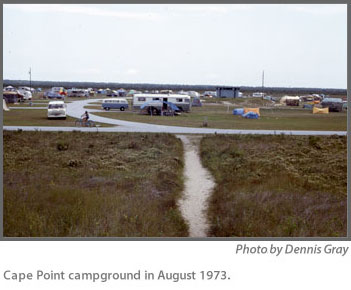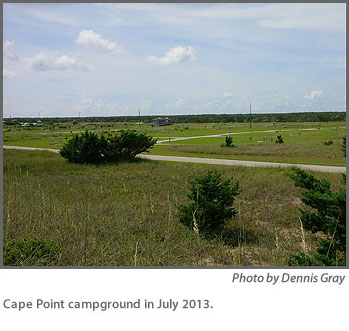Assuming that access to Cape Point won?t reopen to off-road vehicles for at least another two weeks, this year will set a record for the amount of time that the popular fishing, shelling, and family gathering place has been closed to vehicles since 2008 ? and probably in the history of the seashore.
Access to the Point was closed to ORVs on April 9. Now it appears that the earliest it could reopen is Aug. 23. That would be a total of 4 months and 14 days.
Of course, the Point has not been closed that entire time. In fact, it?s open now ? but ORVs can?t get there. Pedestrians can get there if they wade in the water around the closed area where two American oystercatcher chicks are foraging in an ORV route.
The chicks are taking short flights, but have not fledged. The Park Service says they are ?heavy? birds and ?awkward flyers? that take longer to sustain longer flights.
Shortly, the area where the chicks are foraging could be opened to pedestrians. However, according to the 2012 final rule and ORV plan, the park must wait until two weeks after the area opens to pedestrians to open it to ORVs.
This two-week rule applies only to American oystercatchers, apparently because they are ?heavy? and ?awkward flyers.?
It is disturbing to many who favor more reasonable ORV access that oystercatchers are not even a federally listed species. They are not listed as endangered or threatened as are piping plovers and sea turtles.
These birds are a state ?species of concern? only, but the Park Service says it still has an obligation to protect them.
It?s also disturbing that this caveat about oystercatchers is written into the final rule, which give park management no wiggle room or discretion when it comes to managing resources and providing public access.
So the oystercatcher chicks will get their extra two weeks unless or until Congress passes a bill to overturn or modify the ORV plan, a court finds that the National Park Service erred in the process it used to devise the plan, or the plan can be modified by park management in three more years.
One modification that beach access groups have been pushing for is corridors around nesting birds and unfledged chicks.
If ever there was a good case for corridors, it?s this one. Two birds, not federally listed, are keeping the most famous and popular fishing spot on the East Coast closed to ORVs.
It seems the reasonable, prudent way to proceed would be for seashore managers to provide a corridor that would protect the birds but still give us ORV access.
And, yes, you can wade in the water around the birds and still fish at the Point. But only those of us in very good physical shape can wade through breaking waves carrying fishing tackle and bait.
Historically, birds were protected in the Cape Point area by symbolic fencing ? posts and strings that closed off an area for nesting in the interior of the beach. ORV and pedestrian access was allowed along the shoreline.
About a decade ago, seashore managers, mindful of the fact that the park had no ORV plan as it was required to have, began experimenting with other ways of protecting birds until there was a plan and final rule.
For several summers, the Park Service experimented with corridors and escorts through nesting areas.
Then in October of 2007, environmental groups that had found a sympathetic federal judge sued the Park Service over the lack of an ORV rule and plan. On April 30, 2008, U.S. District Court Judge Terrence Boyle signed a consent decree that ended that lawsuit.
The consent decree was in force until the park came up with a final ORV plan, which it did in February 2012.
Since the summer nesting season of 2008, here are the dates that ORV access to Cape Point was closed:
- 2008. May 5 until about Aug. 1.
- 2009. April 14 until July 29
- 2010. May 13 until July 21
- 2011. March 18 until July 18.
- 2012. April 9 until Aug. 3
So this year?s closure of Point ORV access, which could go to Aug. 23 or beyond, will be a record for an area that is arguably the most popular with seashore visitors.
In addition, Ramps 43 and 44 continue to have very limited access for ORVs, and Ramp 43 was closed for about a month by a piping plover nest for the first time ever.
There is something wrong with this picture.
ACCESS AND THE CAPE POINT CAMPGROUND
Dennis Gray of Dayton, Ohio, whose family has been coming to Hatteras Island for decades, sent me some interesting photos last month when he was visiting.

The Gray family now owns a cottage in Frisco, but they, like many others, were introduced to the seashore by camping in the park.
Back in the 1970s, when the Gray family first started camping on Hatteras, Cape Point Campground was very popular.
There is a ramp, Ramp 45, in the back of the campground, which provides ORV access to the South Beach. And it is a reasonable trek on foot to the ocean beach for vacationing families.
However, in more recent years, the Cape Point Campground has been less popular, though it is still open from Memorial Day until Labor Day.
One problem has been flooding after storms and other big rain events.
But the big issue in recent years is the lack of access to the beach.
This summer Ramp 45 has been closed to ORVs and pedestrians. Furthermore, Ramps 43 and 44 have also been closed for weeks at a time.
So the folks camping at Cape Point campground could drive to the Buxton Beach at the old lighthouse site, which is not open to ORVs, or they had to go to Ramp 38 south of Avon or Ramp 49 in the south end of Frisco for ORV access.

Last month, Gray sent me a photo from his family?s vacation back in 1973 when the campground was packed and one he took in mid-July when the campground was nearly empty.
I found the photos very interesting. All those folks in the campground shopped for groceries, ice, bait, and whatever in Buxton. Now they are almost all gone.
It?s no wonder that some businesses in Buxton are struggling with the new, more extensive beach closures.



